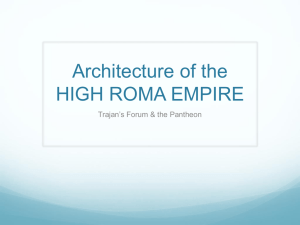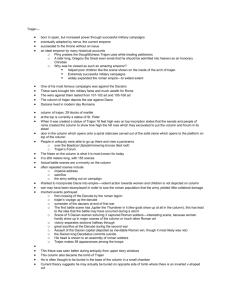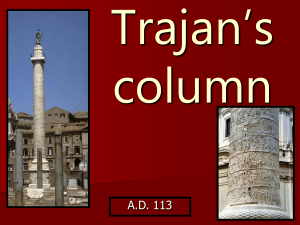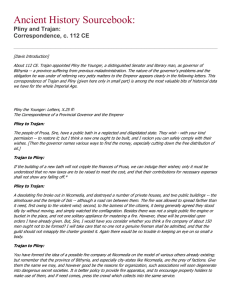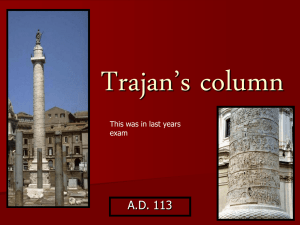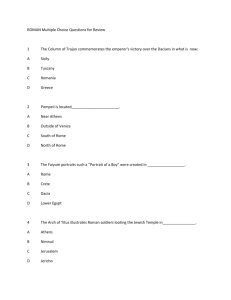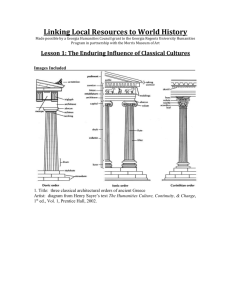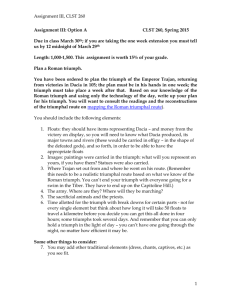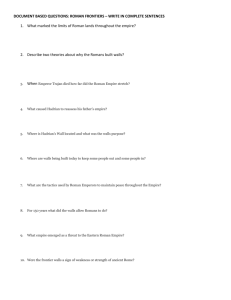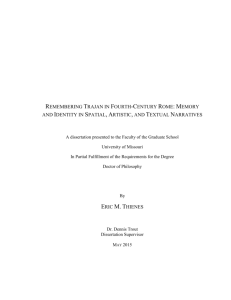Rome: High Empire Notes
advertisement
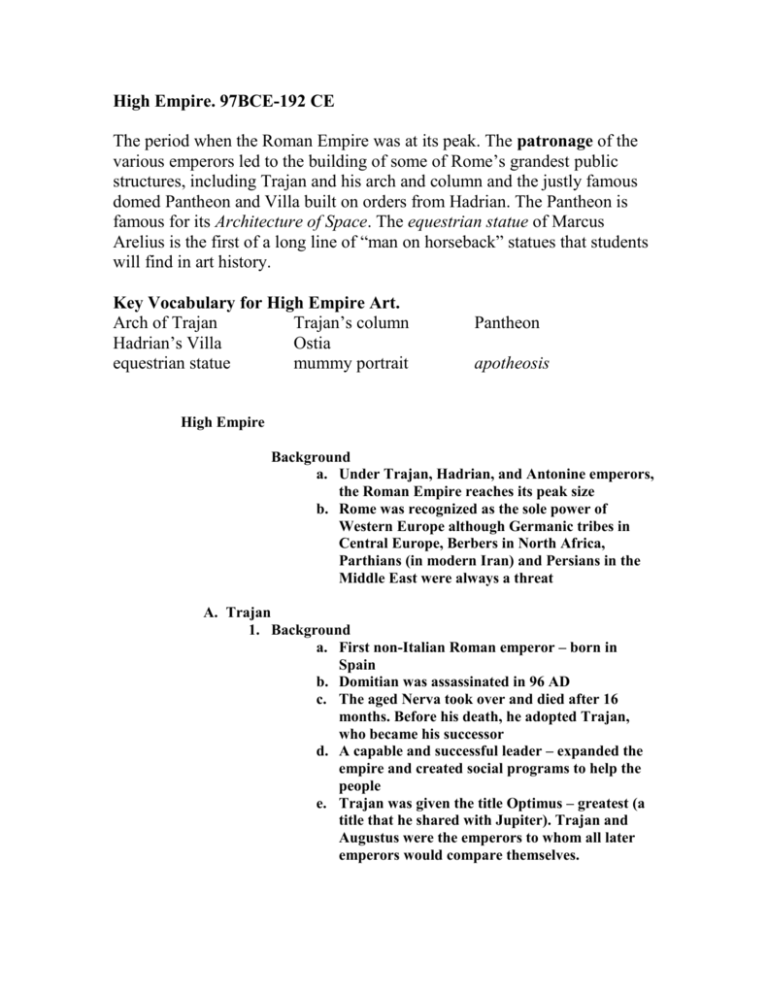
High Empire. 97BCE-192 CE The period when the Roman Empire was at its peak. The patronage of the various emperors led to the building of some of Rome’s grandest public structures, including Trajan and his arch and column and the justly famous domed Pantheon and Villa built on orders from Hadrian. The Pantheon is famous for its Architecture of Space. The equestrian statue of Marcus Arelius is the first of a long line of “man on horseback” statues that students will find in art history. Key Vocabulary for High Empire Art. Arch of Trajan Trajan’s column Hadrian’s Villa Ostia equestrian statue mummy portrait Pantheon apotheosis High Empire Background a. Under Trajan, Hadrian, and Antonine emperors, the Roman Empire reaches its peak size b. Rome was recognized as the sole power of Western Europe although Germanic tribes in Central Europe, Berbers in North Africa, Parthians (in modern Iran) and Persians in the Middle East were always a threat A. Trajan 1. Background a. First non-Italian Roman emperor – born in Spain b. Domitian was assassinated in 96 AD c. The aged Nerva took over and died after 16 months. Before his death, he adopted Trajan, who became his successor d. A capable and successful leader – expanded the empire and created social programs to help the people e. Trajan was given the title Optimus – greatest (a title that he shared with Jupiter). Trajan and Augustus were the emperors to whom all later emperors would compare themselves. 2. Founded Timgad, colony for army veterans. Started out with Hippodamian plan. More chaotic outside of original city boundaries as it grew. 3. Trajan’s Forum a. Fora (plural of forum) were civic centers of Roman cities. b. Fora usually included government buildings such as a basilica, temples to gods, and a market place. c. The Republican Forum was the original forum in Rome, but famous Roman leaders beginning with Julius Caesar added their own additions. Trajan’s Forum was the largest. d. Key facts: i. The architect of Trajan’s Forum was APOLLODORUS of Damascus – famous architect who worked for Trajan, built a bridge over the Danube River ii. Trajan’s Forum included the Basilica Ulpia (Trajan’s family name was Ulpius), a temple for Trajan after he died and was promoted to be a god, libraries, and a theater. iii. Trajan’s Forum also included the first mall – a marketplace that sold all types of goods from all over the Roman Empire. APOLLODORUS designed the markets of Trajan as well. iv. The design of Trajan’s Marketplace makes extensive use of concrete groin vaults. 4. Trajan’s Column (dedicated 112 CE) a. An amazing monument – 128 feet tall and once topped with a heroic nude statue of Trajan (today, a statue of Saint Peter decorates the top) b. Apollodorus probably conceived of this monument c. Part of his forum located between the Basilica Ulpia and Temple of Trajan d. Celebrated his two successful military campaigns against the Dacians e. A 625 foot frieze decorated with 150 different scenes of about 2,500 figures. At one point, the scenes were colored. f. Shows various different aspects of a Roman military campaign including transporting troops and building camps. Only about ¼ of the scenes show actual fighting. g. Scenes show Trajan commanding and addressing his troops and sacrificing to the gods. h. The square base of Trajan’s Column serves as his tomb. His and his wife Plotina’s ashes are stored inside the base. The base is decorated with captured Dacian arms and armor. 5. Arch of Trajan, ca. 114-118 CE a. Trajan opened a new road in southern Italy called the Via Traiana in 109 CE. b. Years later, an arch was erected in his honor. c. The arch is similar to the Arch of Titus but is covered in exterior reliefs advertising Trajan’s great achievements i. He gives extra food to needy children ii. He opened a new port at Ostia, Rome’s harbor at the mouth of Tiber River. iii. He founded a colony for army veterans. iv. The emperor was “all things to all people.” v. The attic of the arch shows a relief of Jupiter handing Trajan a lightning bolt, granting him dominion over the universe. 6. Circus Maximus a. Trajan rebuilt the Circus Maximus which was the venue for chariot races. b. Funerary relief of a circus official, Ostia, 20”high; early example of a continuous narration (compare with Trajan’s column); non-elite style (for freedmen & working class), i.e. disregard for illusionism of early empire. Shakes hands with statue of wife means she’s dead and he’ll be with her in the afterlife. B. Hadrian 1. Background a. A fellow Spaniard, adopted by Trajan to succeed him b. Admirer of Greek culture, loved the arts, architecture, and literature c. Wore a beard to imitate the appearance of Greek philosophers d. Amateur architect e. Had Apollodorus of Damascus assassinated for disrespecting him and being overly critical of his architectural designs. 2. Portrait Bust of Hadrian a. Hadrian took the throne at the age of 41. He reigned for two decades. b. He is also depicted as a mature adult who never ages. c. Hadrian’s bearded appearance set a trend for future emperors. d. Resembles Kresilas’ portrait of Pericles, the great Athenian leader 3. Pantheon a. Built in Rome between 118-125 CE during Hadrian’s reign b. Portico i. Porch-like entrance into the building ii. 16 columns each weighing 60 tons iii. Resembles a Greek temple (Corinthian columns, entablature with post and lintel support, pediment) c. Rotunda i. A huge dome resting on a drum ii. Influenced by Greek tholos iii. Dome is 142 feet high with a diameter of 142 feet iv. A perfect hemisphere v. Dome includes COFFERS – recessed panels which decorate the dome and relieve weight from the dome. The coffers decrease in size from the base of the dome to the oculus to give the illusion of greater height. d. Oculus i. Circular opening 30 feet in diameter located at the apex of the dome ii. Only source of light e. What does it all symbolize? i. The interior could be imagined as the orb of the earth ii. The dome is the vault of the heavens iii. The ceiling was once covered with gilded bronze rosettes which enhanced the dome’s symbolism as the starry heavens iv. As the sun passes through the sky, a natural spotlight is cast into the rotunda, progressively illuminating the interior. To the Romans, the sun symbolized the eye of Jupiter, and its penetrating presence inside the temple seemed to make the deity manifest. v. 7 shrines representing 5 planets and 2 luminaries (sun and moon) f. How was the Pantheon constructed? i. Illustrates the uses and importance of CONCRETE ii. Began with a concrete foundation – a ring of concrete 15 feet deep and 24 feet wide iii. 8 enormous concrete piers spaced to create 7 recesses iv. 6 different mixtures of concrete used from base of drum to the top of the dome – heavier mixture with more stone toward the bottom, lighter mixture with fine pumice toward the top v. Dome’s thickness decreases as it nears the oculus vi. Dome’s weight was lessened without weakening its strength through the use of COFFERS. vii. Rain was drained off by small inconspicuous openings in the floor which slopes slightly toward the center of the building. g. Importance i. One of the most influential designs in architectural history ii. Influenced Palladio’s Villa Rotunda iii. Influenced designs by Thomas Jefferson such as his home Monticello. 4. Hadrian’s Villa, Canopus and Serapeum , Tivoli, 125 – 128 CE. Designed at least partially by Hadrian. Inspired by trip to Egypt, but very original design a. Canopus = pond b. Serapeum = grotto (a small cave or cavern, or a structure designed to look like one). c. Arcuated lintel! Both respect for Greek design and willingness to break the rules. 5. Al-Khazneh (“Treasury”), Petra, Jordan 2nd C. CE. a. Cut into living rock b. Tomb facade c. Roman “baroque” d. Count the ways liberties were taken with Greek formulae. 6. Insula, Ostia (Rome’s harbor) a. Over 90% of Rome’s and Ostia’s inhabitants lived in insulas (apartments) made out of brick. b. Brick was not covered. Was considered attractive. Made brick classical motifs such as pilasters and engaged columns for decoration c. Very little light and air from courtyards. Thus focus was outside in insulas: windows. d. Modest inside decoration. Finer apartments had mosaic floors and frescoed ceilings. Mosaics usually B&W. 7. Ostia funerary art a. For working class. b. Painted terracotta plaques showing the deceased doing his/her occupation C. The Antonines (138 – 192 CE) i. History/Background: Hadrian adopted 51 year-old Antonius Pius as his son and successor and required Antonius to adopt Marcus Aurelius and Lucius Verus. Hadrian dies later that year and was declared a god. Antonius Pius ruled for thirteen years. 1. On A.P.’s death M.A. and L.V. erected a memorial to him. On pedestal one side has inscription, one side has Apotheosis, and two sides have identical versions of the decursio (ritual circling of the imperial funerary pyre). a. Slide: Apotheosis (ascent to heaven) of Antonius Pius and Faustina, relief on pedestal of the column of A.P. ,Rome, ca. 161 CE. i. Elegant, classical proportions ii. Single ground plane iii. Campus Martius (Field of Mars, island in Tiber river) personified by youth with obelisk iv. Rome personified by Roma leaning on shield with Rom. and Remus being suckled by she-wolf. v. A.P. and Faustina being elevated to realm of gods on a winged personification of unknown ID. vi. Faustina had been dead for 20 years when A.P. died. Conflated (mixed) different times. New to classical repertoire (stock of things available). Implies A.P. was faithful husband after wife’s death. b. Decursio: Break with classical tradition i. Figures stockier ii. Not a window onto the world iii. Ground plane is entire surface (looking down on action, sort of) iv. Horses and riders on patches of floating earth v. DISSATISFIED WITH OLD MANNER, started using conventions of art made for “freedmen.” See Amiternum funerary relief. vi. What is a contemporary version of this co-opting (appropriate, take over) of the art of the lower classes by the upper classes? 2. Marcus Aurelius a. Last of “Good Emperors” b. Seen in the movie “Gladiator” c. Known as a philosophical man d. Author of the Meditations – a series of writings composed during his military campaigns – an important work of Stoic philosophy e. Spent many years on military campaigns to defend the northeastern frontier of the Roman Empire from Germanic tribes (opening scene of Gladiator) f. Portraits of Marcus Aurelius depict him as a aged, wise man – first portraits of an emperor that give human qualities of the man – sets a trend for later portraits 3. Equestrian Statue of Marcus Aurelius a. Only equestrian statue to survive. Saved because Christians mistakenly thought it was Constantine, the first Christian emperor. b. Trajan’s equestrian statue was not found. c. Has traces of original gilding (gold foil). d. Power is emphasized by his control over his lively and rather nervous horse e. His right hand is extended in a gesture of power and clemency for an enemy f. Originally, a figure of a defeated enemy was shown crouching beneath the horse’s upraised hoof g. During the 17th century, the statue was placed in the center of the Campidoglio (Capitoline Hill) which was renovated by Michelangelo. h. Today, the statue is in the Capitoline Museum and a replica stands in the center of the Campidoglio plaza. i. What does it convey? i. M.A. is oversized for his horse. Commanding a frisky animal. M.A. very much in charge…over whole world. ii. Portrait head shows cares. See Portrait head of M.A. ca. 175 – 180 CE. Beyond republican verism: Weary, sad, worried? See his inner life? ii. Portrait of Marcus Aurelius and challenge to classical style in reliefs is beginning of end of hegemony (leadership or dominance) of Classical art in Greco-Roman World D. Funerary Practices i. Private citizens started to favor inhumation (burial) over cremation (burning). Need bigger container for body vs. ashes. ii. Sarcophogi (stone coffins) 1. Portraits of deceased sometimes portrayed and masqueraded like heroes and heroines (copy idea from emperors) 2. Often were produced in workshops from pattern books. 3. Often showed scenes from Greek mythology 4. Note chunkier bodies 5. Reclining woman: Etruscan influence 6. Faiyum encaustic portrait: Romans in Egypt adopted mummification. Portrait mask (relief) was replaced by painted portrait. Probably painted from life.
